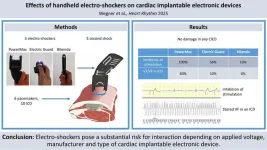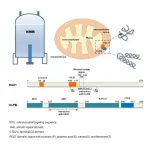(Press-News.org) A pivot from fossil fuels to clean energy technologies by 2060 would improve energy security and reduce trade risks for most nations, according to an April 9 study in Nature Climate Change.
Lithium, nickel, cobalt, copper, and rare earth minerals are among the prized materials for countries and corporations racing to secure supplies for energy systems that do not add greenhouse gases to our atmosphere. Unlike fossil fuels, natural reserves of these materials are most concentrated in the Global South, shuffling the geopolitics of energy and global trade.
“Most people are focused on the new stuff that could be a problem, and not really considering the security benefits of moving away from fossil fuels,” said Steve Davis, the study’s senior author and a professor of Earth system science in the Stanford Doerr School of Sustainability. “For most countries in a net-zero emissions system in the future, trading off the reduced dependence on imported fossil fuels and increased dependence on these new materials is actually a win for energy security.”
Even for the United States, which has some of the world’s largest fossil fuel reserves but only a sliver of critical mineral deposits, decarbonization could boost energy security, especially if the country cultivates new trade partners, the researchers found.
Since 2020, the U.S. has exported more crude oil and petroleum products than it has imported – but it still imports millions of barrels daily, mostly from Canada, Mexico, Saudi Arabia, Iraq, and Colombia. “Generating electricity with solar and wind will require more imports than using abundant gas and coal resources in the U.S., but reduced dependence on foreign oil will be a big advantage as transportation is electrified,” Davis said.
Oil-rich nations including Russia and Saudi Arabia are among the minority of countries that would see energy security decline in net-zero scenarios even with expanded trade networks.
Systematic analysis and a new trade risk index
To reach their conclusions, the scientists systematically analyzed the range of each country’s potential new vulnerabilities under decarbonization relative to those associated with continued reliance on fossil fuels.
As a first step, lead author Jing Cheng, a postdoctoral scholar in Davis’s Sustainable Solutions Lab at Stanford, built a database of countries with reserves of oil, gas, coal, uranium, biofuels, and any of 16 materials that are critical for clean energy technologies, along with the trade flows of these resources between countries.
The researchers calculated how much of these resources would be required to meet energy demand in each of 236 countries in 1,092 different scenarios for reaching net-zero carbon emissions globally by 2060. Modeled by the Intergovernmental Panel on Climate Change, or IPCC, the scenarios span a broad range of possible changes to the energy mix across the globe and within individual countries. Some are more dependent on nuclear energy, for example, while others incorporate more solar or wind power.
For the thousands of combinations of trade relationships and resource needs, the team estimated the level of risk in each country’s transportation and electricity sectors, and overall energy system. They quantified these risks using a new “trade risk index” based on the availability of domestic reserves, the share of demand for a given fuel or material met by imports, the economic value of the imports, and a measure of market concentration widely used to quantify energy security.
Countries benefit from deeper cuts to fossil fuel reliance
The researchers found that if all countries maintain their current networks, trade-related risks to energy security would decline on average by 19% in net-zero scenarios. If countries expand their networks and trade with all resource owners, then trade risks on average would fall by half.
Reducing the need for imported virgin materials – whether by making technologies last longer, ramping up recycling, or developing less material-intensive designs – is another way for mineral-poor countries to minimize trade risks while eliminating fossil fuels. According to the study, trade risks fall on average by 17% – and by more than 50% for the U.S. – with a quadrupling of today’s meager recycling rates for critical minerals such as lithium, nickel, and indium.
The authors found a U.S. energy mix made up of approximately 70-75% renewables like solar, wind, and biomass; 15-20% fossil fuels; and 10% nuclear would minimize the country’s trade risks across all the modeled scenarios for reaching net-zero by 2060, although other mixes could offer advantages such as lower costs or less air pollution. Today, the U.S. relies on fossil fuels for about 83% of its energy needs, with nuclear energy and renewables providing roughly equal shares of the remainder.
Compared to solar power, wind stands to deliver greater energy security benefits for the U.S. – at least, with the trade relationships that existed at the time of the study. The materials needed to build turbines in recent years have come from a relatively large number of trade partners, Cheng explained. “However, advancing solar photovoltaic manufacturing technologies with more widely available, lower-grade silicon sources, or expanding trade networks with countries rich in silicon and manganese reserves, could further significantly bolster the nation’s energy security,” she said.
The key, as ever, is to avoid putting all the eggs in one basket. “If you’re importing a large fraction of what you need, that’s a vulnerability. If it’s all from a single other party, there’s a lot of risk that some natural disaster or geopolitical conflict could disrupt that supply,” Davis said. “You want to diversify imports among as many sources as you can.”
The security benefits of diversification have limits, however. The study results indicate that keeping fossil fuels in the mix generally drags down nations’ energy security. “It is ultimately encouraging that most countries’ trade risks decrease in net-zero scenarios,” the authors conclude, “and that the greatest improvements often occur in the countries which most drastically reduce their reliance on fossil fuels.”
Co-authors of the study include Karan Bhuwalka, a research engineer in the Stanford Doerr School of Sustainability’s Department of Energy Science & Engineering. Bhuwalka is also a staff scientist at the STEER program, a partnership between the SLAC-Stanford Battery Center and the Precourt Institute for Energy that is funded by the U.S. Department of Energy.
Co-author Ken Caldeira is a senior staff scientist emeritus at the Carnegie Institution for Science who is also affiliated with Gates Ventures and a visiting scholar in Davis’s research group in the Stanford Doerr School of Sustainability’s Department of Earth System Science. Additional co-authors are affiliated with Tsinghua University, Beijing Normal University, and Peking University in Beijing, China.
Co-authors Dan Tong and Qiang Zhang of Tsinghua University were funded by a grant from the National Natural Science Foundation of China.
END
Decarbonization improves energy security for most countries, Stanford study finds
A pivot from fossil fuels to clean energy technologies by 2060 would improve energy security and reduce trade risks for most nations, according to an April 9 study in Nature Climate Change.
2025-04-09
ELSE PRESS RELEASES FROM THIS DATE:
Poor oral health linked with body pain and migraines in women
2025-04-09
New research from the University of Sydney has revealed poor oral health is significantly associated with higher instances of migraines, abdominal and body pain in women.
Published in Frontiers in Pain Research, the world-first study identified specific oral microbes correlated with certain pain conditions, suggesting a potential relationship between the oral microbiome and the nervous system.
The findings highlight the importance of good oral health to potentially mitigate pain and improve overall wellbeing, prompting further exploration into the role of oral microbiota in chronic unexplained ...
How is climate change affecting seasonal allergies?
2025-04-09
A review published in The Laryngoscope indicates that climate change’s effects on pollen seasons and concentrations are contributing to increasing rates of allergic rhinitis, or hay fever.
When investigators assessed research published between 2000 and 2023, they identified 30 studies that reported on the current epidemiological state of allergic rhinitis, described factors related to climate change, and observed how global warming is affecting pollen seasons and allergy symptoms.
Sixteen studies reported longer pollen seasons and/or higher pollen concentrations related to climate change. As an example, total pollen emissions in the U.S. are projected to increase by 16–40% ...
Does universal preschool lead to better academic outcomes?
2025-04-09
Several states, including Georgia, offer state-funded pre-kindergarten programs to students regardless of their family’s income. New research in Economic Inquiry investigates whether such programs offer long-lasting academic benefits to all students.
Using enrollment lottery data from a large school district in metro Atlanta, investigators found that lottery-winning enrollees of school-based pre-kindergarten entered kindergarten more prepared in both math and reading than non-winning peers. Gains tended to fade by the end of kindergarten, however, and some negative achievement effects ...
Could fish swim bladders be useful in a treatment for heart failure?
2025-04-09
Hydrogels, which are soft materials formed by crosslinking polymers, could have a variety of medical applications. In research published in Advanced Science, investigators developed an injectable hydrogel containing components of fish swim bladders and used it to repair damaged heart tissue.
The fish swim bladder is an organ that aids fish in floating in water and is composed of collagen, glycosaminoglycans, and elastin, closely resembling parts of the human heart.
Experiments revealed that the researchers’ fish swim bladder–based hydrogel enhances cardiac cell adhesion and stretching while promoting new ...
Does cancer treatment affect connections in the brain?
2025-04-09
New research published in the Journal of Magnetic Resonance Imaging has uncovered changes in brain connectivity during chemotherapy in patients with breast cancer.
In the study of 55 patients with breast cancer and 38 controls without cancer, investigators conducted functional magnetic resonance imaging scans of participants’ brains over several months.
Scans from patients revealed changes in brain connectivity, particularly in the frontal-limbic system (involved in executive functions) and the cerebellar cortex (linked to memory) throughout the course of treatment. These changes got worse and spread more as chemotherapy continued.
“The ...
Unsafe driving during school drop offs at ‘unacceptable’ levels
2025-04-09
Risky driving by parents and other motorists who do the school run is putting children in danger, according to a study published in the peer-reviewed journal Traffic Injury Prevention.
Double parking, not obeying traffic controls and other unsafe behavior occurs at the majority (98%) of elementary schools during morning drop-off times.
The authors analyzed data from more than 500 schools in Canada and say hazardous driving is an “urgent and serious” issue. The most observed misdemeanour was to drop a student ...
RAND survey reveals varied curriculum use and time constraints among public school pre-k teachers
2025-04-09
According to a new RAND survey, over 80% of public school-based pre-kindergarten (pre-K) teachers use multiple curriculum materials. Some combine materials that focus on a particular domain – such as literacy or numeracy – while others use material that covers many domains at once, and some use both. More than two-thirds reported using materials that they created themselves, often in conjunction with commercial curricula.
Most public school-based pre-K educators surveyed believe their instructional materials are high quality, especially ...
Study finds handheld electro-shockers can pose risk for individuals with cardiac implants
2025-04-09
Philadelphia, April 9, 2025 – Research has found that handheld electro-shockers commonly used for self defense can potentially interact with cardiac implantable electronic devices (CIEDs) such as pacemakers, putting individuals at risk. The study in Heart Rhythm, the official journal of the Heart Rhythm Society, the Cardiac Electrophysiology Society, and the Pediatric & Congenital Electrophysiology Society, published by Elsevier, shows that the individual interactive risk is primarily based on the applied voltage, but also on the manufacturer and type of implanted CIED.
The use of TASER pistols by security forces has been controversial ...
Holograms that can be grabbed and manipulated
2025-04-09
Doctor Elodie Bouzbib, from Public University of Navarra (UPNA), together with Iosune Sarasate, Unai Fernández, Manuel López-Amo, Iván Fernández, Iñigo Ezcurdia and Asier Marzo (the latter two, members of the Institute of Smart Cities) have succeeded, for the first time, in displaying three-dimensional graphics in mid-air that can be manipulated with the hands.
'What we see in films and call holograms are typically volumetric displays,' says Bouzbib, the first ...
Novel structural insights reveal the mechanism of mitochondrial protein HAX1 interaction with CLPB
2025-04-09
A recent study published in Magnetic Resonance Letters has revealed for the first time the interaction mechanism between the mitochondrial proteins HAX1 and CLPB, filling the research gap between these two key proteins in the field of structural dynamics and functional association. By integrating multiple biophysical techniques, the research team based in Hefei, China, revealed the high-affinity binding properties between the two and their structural basis, which provides new research perspectives for understanding diseases related to abnormal mitochondrial function.
HAX1 and CLPB: from structural differences to functional synergy
HAX1 ...
LAST 30 PRESS RELEASES:
Norbert Holtkamp appointed director of Fermi National Accelerator Laboratory
New agentic AI platform accelerates advanced optics design
Biologists discover neurons use physical signals — not electricity — to stabilize communication
Researchers discover that a hormone can access the brain by hitchhiking
University of Oklahoma researcher awarded funding to pursue AI-powered material design
Exploring how the visual system recovers following injury
Support for parents with infants at pediatric check-ups leads to better reading and math skills in elementary school
Kids’ behavioral health is a growing share of family health costs
Day & night: Cancer disrupts the brain’s natural rhythm
COVID-19 vaccination significantly reduces risk to pregnant women and baby
The role of vaccination in maternal and perinatal outcomes associated with COVID-19 in pregnancy
Mayo Clinic smartwatch system helps parents shorten and defuse children's severe tantrums early
Behavioral health spending spikes to 40% of all children’s health expenditures, nearly doubling in a decade
Digital cognitive behavioral treatment for generalized anxiety disorder
Expenditures for pediatric behavioral health care over time and estimated family financial burden
Air conditioning in nursing homes and mortality during extreme heat
The Alps to lose a record number of glaciers in the next decade
What makes a good proton conductor?
New science reporting guide published for journalists in Bulgaria
New international study reveals major survival gaps among children with cancer
New science reporting guide published for journalists in Turkey
Scientists develop a smarter mRNA therapy that knows which cells to target
Neuroanatomy-informed brain–machine hybrid intelligence for robust acoustic target detection
Eight SwRI hydrogen projects funded by ENERGYWERX
The Lundquist Institute and its start-up company Vitalex Biosciences Announces Strategic Advancement of Second-Generation fungal Vaccine VXV-01 through Phase 1 Trials under $40 Million Competitive Con
Fine particles in pollution are associated with early signs of autoimmune disease
Review article | Towards a Global Ground-Based Earth Observatory (GGBEO): Leveraging existing systems and networks
Penn and UMich create world’s smallest programmable, autonomous robots
Cleveland researchers launch first major study to address ‘hidden performance killer’ in athletes
To connect across politics, try saying what you oppose
[Press-News.org] Decarbonization improves energy security for most countries, Stanford study findsA pivot from fossil fuels to clean energy technologies by 2060 would improve energy security and reduce trade risks for most nations, according to an April 9 study in Nature Climate Change.


